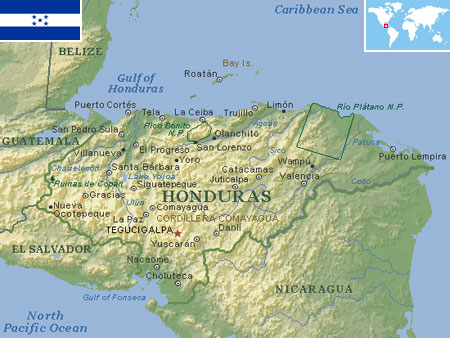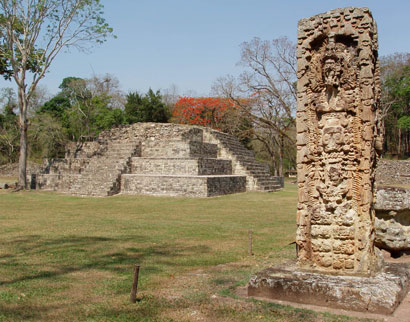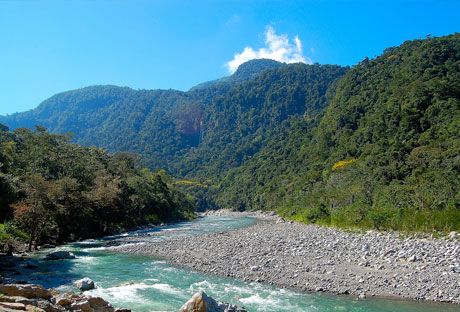Honduras
Country statistics

Land area: 43,201 sq miles (111,891 sq km)
Total area: 43,278 sq miles (112,090 sq km)
Population (2012 est.): 8,296,693 (growth rate: 1.838%); birth rate: 24.66/1000; infant mortality rate: 19.85/1000; life expectancy: 70.71
Capital City: Tegucigalpa
Monetary unit: Lempira
Languages: Spanish (official), Amerindian dialects; English widely spoken in business
Ethnicity/race: mestizo 90%, Amerindian 7%, black 2%, white 1%
Religions: Roman Catholic 97%, Protestant 3%
Country introduction

Honduras is a country in Central America, bordered to the west by Guatemala, to the south-west by El Salvador, to the south-east by Nicaragua, to the south by the Pacific Ocean at the Gulf of Fonseca, and to the north by the Gulf of Honduras, a large inlet of the Caribbean Sea. Honduras also controls a number of islands as part of its offshore territories.
Beautiful mountains are the defining feature of inland Honduras. The rugged mountains with its numerous valleys make up over 80% of the country's land area that run from east to west, cut by rivers flowing into both the Caribbean and Pacific. The western mountains are particularly breathtaking and have the highest peaks, with the Pico Congolón at an elevation of 2,500 m (8,202 ft) and the Cerro Las Minas at 2,850 m (9,350 ft).
The north coast of Honduras is made up of river valleys and low coastal plains, which is somewhat swampy and dotted with mangroves. While large areas of land in Honduras are unsuitable for cultivation there are some large fertile valleys of the Northern Caribbean lowlands that are cultivated with banana plantations. The Caribbean coastline also feature hundreds of miles of white sand beaches and just off shore it has the magnificent Bay Islands Coral Reef. Roatán, Útilatila and Guanaja are the three inhabited islands in the Bay Islands. These coral barrier islands make up the southern part of the Mesoamerican Barrier reef System in Honduras, the second-longest reef in the world.
The eastern regions have beaches that are definitely more welcoming to travelers who are looking for a little seclusion and is also home to one of Central America's largest unspoiled tropical rainforest in the Mosquitia region.
The lowlands in the south form a plain along the Pacific coast. The Gulf of Fonseca in the south-west contain many islands which have volcanic peaks. Most Hurricanes occasionally form over the Pacific and move north to affect Southern Honduras. While Honduras is little affected by the earthquakes that plague other Central American nations, the country's biggest natural threat comes from hurricanes and frequent flooding caused by heavy rains.
In the western region is Copán, site of the Copán Ruins, one of the most impressive displays of ancient Mayan culture. The majority of the population lives in the western half of the country, while the second-largest concentration of people is in the Cortés region which extends northwards from Lake Yojoa towards the Caribbean.
The culture

Honduras was home to the great Mayan Empire which flourished until about AD 800 when the Mayan population began to decline. It was also discovered by Christopher Columbus who landed there in 1502 and called the area Honduras (depths) because of the deep waters off the north coast. Honduras was already occupied by many indigenous peoples when the Spanish arrived in the 16th century. Following independence from Spain in 1821 and from Mexico in 1822, the country had been dotted with military coups, rebellions, dictatorships, and chess-game politics. Despite a checkered past the culture of hondrus still remains vibrant and unique today.
The predominant ethnic group in Honduras are mestizo, people who are mixed native and European, mostly Spanish. Mestizos account for 90% of the population of Honduras along with several other minority ethnic groups including European, African, Asian, Arab, and indigenous Indian descent.
Honduran music takes most of its elements from African and European nations and combines them into a style all their own. They do this by using Spanish rhythms. Traditional Honduran musicians use unique instruments such as the marimba, caramba, and the conch shell. However, in general, Hondurans prefer music from Mexico or the United States, in different rhythms.
Art is such a huge part of the culture in Honduras. Most of the artwork done by contemporary Honduran painters reflects many aspects of Honduran life, such as the climate which is tropical and mountainous, the hardworking citizens, and most of all the vibrant spirit of these unique people. López Rodezno is a Honduran painter who founded the National School of Arts and Crafts in Comayagüela, which maintains a permanent contemporary art exhibit featuring many murals by various artists. A traditional Amerindian theme, the "rain of fish" (a "tornado" that travels over the ocean, sucks up fish and then drops them over villages), frequently occurs in Honduran art. Brightly colored handicrafts, such as model animals of clay or wood and jewelry, are everywhere in Honduras.
Literature in Honduras flourished in the Romantic period. Of late the trend in literature has shifted towards political oriented writing. Many writers, such as José Trinidad Reyes and José Cecilio del Valle, have emerged in Honduras, however, many people cannot afford books, so the market for authors is limited. Many authors publish their work in newspapers to gain access to the public.
Hondurus is mostly a Christian country and as a result all the usual holidays attributed to the religion is observed including Christmas and Easter. Christmas is perhaps the biggest celebration of the year for Hondurans. Hondurans set up a nativity scene where they cover the baby Jesus with a blanket, which is then removed to unveil the baby on Christmas Eve. Easter is a two-week celebration with festivals and parades. All schools and most businesses shut down from Palm Sunday to Easter Sunday. Traditionally, the majority of the population travels to the beaches during this time. Other holidays celebrated include Day of the Americas (April 14th), Labor day (1 May), Independence Day (15 Sept), Columbus day (12 Oct.) and Armed Forces Day (21 Oct.). In addition, to these holidays, Honduras has community celebrations honoring patron saints like The Feast Day of the Virgin of Suyapa on February 3, and regional festas such as Carnaval at La Ceiba in the third week of May.
Attractions & landmarks

Honduras's most popular destinations are the Maya ruins of Copán in Western Honduras, near the border of Guatemala. The buildings, sculptures, and immense hieroglyphics at the site provide a unique glimpse of a long lost civilization. Its spectacular features include the Great Plaza with tiered seating for 50,000 people and the nearby Acropolis, considered the royal centre has numerous pyramids and temples. The latter includes the famous Hieroglyphic Stairway, whose 63 steps include some 2,500 individual glyphs, the largest set of pre-Columbian inscribed texts in the Americas. The outer wall of the Plaza contains carved reliefs depicting Copán's 16 rulers. Although one of the most researched Mayan sites, much of Copán remains to be excavated and discovered in its jungle setting.
Sun-seeking travelers looking for quiet beaches and unspoiled reefs are recommended to visit one of the three Bay Islands that lie just 32 to 48 km (20 to 30 miles) off the northern shore. The Bay islands are home to the second largest coral reef in the world and consists of bottlenose dolphins, brightly-coloured parrot fish, manta rays and the enormous whale shark. Roatán the largest of the Bay Islands offers the largest variety of resorts and provides calm, clear beaches for swimming, snorkeling, scuba diving, and many varieties of sea life. Útila, the smallest of the Caribbean Bay Islands delivers big value and big encounters, even allowing visitors to see whale sharks that ply the waters yearly. Guanaja, is the least visited island by tourists but has some spectacular attractions including its forests, rivers, and miles of unspoiled beaches. On the mainland, urban beaches in Tela and Puerto Cortés mix sun, sand, and Honduran culture. Honduras has hundreds of miles of coastline on two oceans, so spending a day on the beaches is one of the great things to do in Honduras.
Heading inland will also allow visitors to experience the rainforests of Parque Nacional Pico Bonito, near La Ceiba, or the more remote Mosquitia area, on the eastern tip of Honduras. The varied terrain includes rainforests and cloud forests that reach almost 3,000 m (9,842 ft) high, mangrove swamps, mountain ranges and savannahs. The region is a biodiversity hotspot, with a concentration of plant and animal species. There are about 250 types of reptile and amphibian, over 700 species of bird and over 110 mammal species, half of them bats.